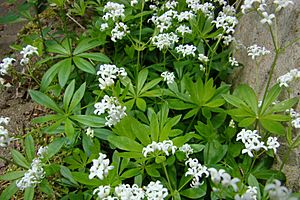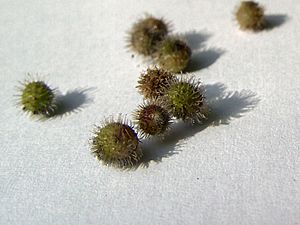Sweetscented bedstraw facts for kids
Quick facts for kids Sweetscented bedstraw |
|
|---|---|
 |
|
| Scientific classification | |
| Genus: |
Galium
|
| Species: |
odoratum
|
| Synonyms | |
|
|
Galium odoratum, also known as sweetscented bedstraw, is a beautiful flowering plant. It's a perennial, which means it lives for more than two years. This plant belongs to the Rubiaceae family.
You can find sweetscented bedstraw growing naturally in many parts of Europe, from Spain to Russia. It also grows in Western Siberia, Turkey, Iran, the Caucasus region, China, and Japan. Sometimes, it grows in the United States and Canada too, even though it's not native there. People often grow it in their gardens because of its pretty flowers and its lovely sweet smell.
This plant is a herbaceous plant, meaning it has soft stems, not woody ones like a tree. It usually grows to be about 30 to 50 centimeters (12 to 20 inches) long. It often lies flat on the ground or uses other plants for support. Some of its other common names are woodruff, sweet woodruff, and wild baby's breath. In German, it's called Waldmeister, which means "master of the woods." Sometimes, people confuse it with other similar plants like Galium triflorum and Galium verum.
Sweetscented bedstraw gets its sweet smell from a special chemical called coumarin. Because of this, it has been used to add flavor to different foods and drinks.
How Sweet Woodruff Grows
The leaves of sweet woodruff are simple and shaped like a spearhead, which is called lanceolate. They are smooth, or glabrous, meaning they don't have hairs. Each leaf is about 2 to 5 centimeters (0.8 to 2 inches) long. These leaves grow in groups of 6 to 9 around the stem, like a circle. These groups are called whorls.
The plant produces small white flowers, each about 4 to 7 millimeters (0.16 to 0.28 inches) wide. Each flower has four petals that are joined at the bottom. The flowers grow in clusters called cymes. After the flowers, small fruits appear. They are about 2 to 4 millimeters (0.08 to 0.16 inches) wide and grow one by one. Each fruit is covered in tiny hooked bristles. These hooks help the seeds spread by sticking to clothes or animal fur, like tiny burrs.
Sweet woodruff likes to grow in places that are partly or fully shaded. It prefers soil that is moist and rich in nutrients. If the summer is dry, it needs to be watered often. You can grow new plants by dividing the plant's roots, separating its rooted stems, or digging up its underground stems called stolons that grow near the surface. It's a great plant to use as a groundcover (a plant that spreads out to cover the ground) or to decorate the edges of gardens, especially in shady areas where other plants might not grow well. In some places, like the Northeast US, deer and chickens usually don't eat it.
Sweet Woodruff: Uses and Safety Tips
As its name odoratum suggests, this plant has a very strong and pleasant smell. This sweet smell comes from the chemical coumarin. The scent actually gets stronger when the plant starts to wilt and stays strong even after it dries. Because of this, dried sweet woodruff is used in potpourri (a mix of dried flowers and spices) and to keep moths away.
Historically, sweet woodruff was used to flavor many things. It was, and sometimes still is, used in a spring drink called "May wine" (known as "Maibowle" or "Maitrank" in German). It also flavored sweet juice punches, syrups for beer (like "Berliner Weisse"), brandy, jelly, jam, and a soft drink from Georgia called Tarhun. You might also find it in ice cream and herbal tea. In Germany, sweet woodruff-flavored jellies, both with and without alcohol, are very popular. It was even used to flavor a fizzy powder called sherbet powder, which is mentioned in a famous German book called The Tin Drum.
However, in Germany, using sweet woodruff to flavor sweets for children was stopped in 1974. This was because the plant has a small amount of a chemical called coumarin, which can be harmful if you eat too much of it. The amount of coumarin increases when the plant dries. For children, who have smaller bodies, even a small amount can cause problems like sickness, headaches, or even liver damage.
Today, the sweet woodruff flavor is still popular in Germany, but it's usually made artificially using other safe flavoring agents for sweets. Products for adults, like alcoholic drinks, are still allowed to have a small, safe amount of coumarin.
See also
 In Spanish: Galium odoratum para niños
In Spanish: Galium odoratum para niños


